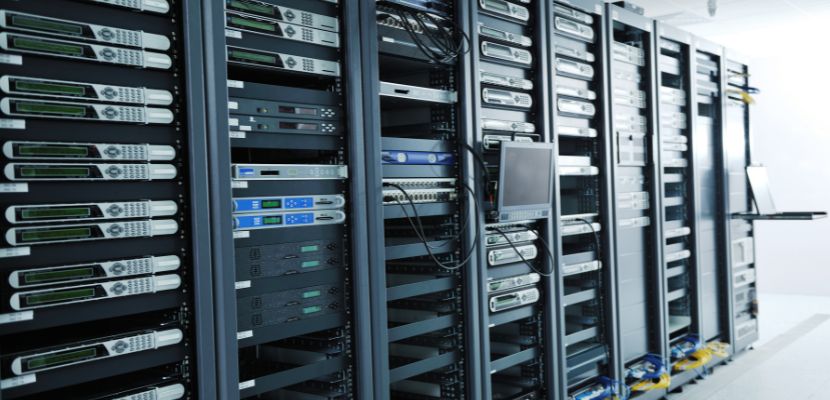Data center solutions encompass a range of technologies, services, and strategies designed to support the storage, processing, and management of data within a centralized IT infrastructure.

What Is a Data Center Solution?
Data center solutions refer to the comprehensive set of technologies, services, and practices used to design, build, manage, and optimize data centers. These solutions support the continuous operation of IT systems by providing the infrastructure necessary for storing, processing, and delivering data and applications.
A data center solution typically integrates physical components such as servers, storage systems, networking equipment, and power and cooling infrastructure with software for virtualization, automation, monitoring, and security. It also includes strategic services like migration, disaster recovery, capacity planning, and hybrid cloud enablement.
The goal of data center solutions is to ensure reliability, scalability, efficiency, and security, enabling organizations to support business operations, meet regulatory requirements, and adapt to changing technology demands.
Data Center Solution Components
Here are the core components of a data center solution, each playing a critical role in supporting and managing IT operations:
- Compute infrastructure. This includes physical and virtual servers that handle application processing and data computation. Modern data centers often use high-density servers with advanced CPUs, GPUs, and memory to support virtualization, cloud workloads, and AI/ML tasks.
- Storage systems. Data is stored using a combination of direct-attached storage (DAS), network-attached storage (NAS), and storage area networks (SAN). These systems vary in performance and scalability, with SSDs used for high-speed access and HDDs or tape for archival and backup.
- Networking equipment. Switches, routers, firewalls, and load balancers form the backbone of connectivity within and beyond the data center. High-speed and redundant networking ensures data availability, low latency, and secure communication between servers, storage, and external endpoints.
- Power and cooling. Uninterruptible power supplies (UPS), generators, and power distribution units (PDUs) maintain consistent power delivery, while HVAC systems manage temperature and humidity. Efficient power and cooling solutions are essential for uptime and equipment longevity.
- Physical security. To protect against unauthorized access, data centers implement biometric scanners, keycards, CCTV surveillance, and mantraps. Physical security complements cybersecurity to protect sensitive data and hardware.
- Virtualization and hypervisors. Virtualization software (e.g., VMware, Hyper-V, KVM) allows multiple virtual machines (VMs) to run on a single physical server, optimizing resource usage and enabling rapid provisioning and migration.
- Data center management tools. These include DCIM (data center infrastructure management) systems, monitoring software, and orchestration tools that help administrators manage resources, monitor performance, detect faults, and automate routine tasks.
- Cloud integration and hybrid support. Modern data center solutions often include integration with public clouds (e.g., AWS, Azure, Google Cloud), enabling hybrid or multi-cloud architectures. This enhances scalability, disaster recovery, and workload flexibility.
- Backup and disaster recovery. Solutions for backing up critical data and ensuring rapid recovery in case of hardware failure, cyber attack, or natural disaster are essential. These may include replication, snapshots, and off-site backups.
- Security and compliance solutions. Firewalls, intrusion detection and prevention systems (IDPS), data encryption, and compliance tools ensure data protection and adherence to regulatory standards like GDPR, HIPAA, or PCI-DSS.
Examples of Data Center Solutions

Here are a few examples of data center solutions commonly used by organizations across industries:
- Cisco Unified Computing System (UCS). A converged infrastructure solution that integrates compute, networking, and storage access into a single, cohesive system. It simplifies data center operations and supports virtualization and cloud workloads.
- Dell VxRail. A hyperconverged infrastructure (HCI) solution co-engineered with VMware. It combines compute, storage, and virtualization in a single appliance, ideal for scaling out data center resources with simplified management.
- Microsoft Azure Stack. A hybrid cloud solution that extends Azure services to on-premises data centers. It enables consistent cloud services, DevOps, and application development across cloud and local environments.
- HPE GreenLake. An as-a-service solution that delivers on-premises infrastructure with cloud-like scalability and billing. It allows organizations to manage workloads locally while benefiting from flexible consumption models.
- Equinix data center services. Provides global colocation, interconnection, and edge services. Businesses can deploy their infrastructure in secure, redundant facilities with direct connectivity to major cloud providers and partners.
What Are Data Center Solutions Used For?
Data center solutions are used to support and manage the critical IT infrastructure required to run applications, store and process data, and deliver digital services. They serve as the backbone of modern enterprise operations by ensuring that computing, storage, networking, and security resources are available, reliable, and scalable.
Organizations use data center solutions for a variety of purposes, including:
- Hosting business applications such as ERP, CRM, and databases
- Storing and managing large volumes of data, including backups and archives
- Running virtualization platforms and cloud workloads
- Supporting disaster recovery and business continuity through redundant systems and failover mechanisms
- Enabling secure, high-performance networking for internal operations and external users
- Meeting regulatory and compliance requirements for data privacy, availability, and security
- Optimizing resource usage through automation, monitoring, and centralized management
Who Needs Data Center Solutions?
Data center solutions are essential for any organization that relies on IT infrastructure to operate, store data, or deliver digital services. This includes a wide range of sectors and business sizes:
- Enterprises and large corporations. These organizations need robust, scalable infrastructure to support complex workloads, large databases, global operations, and high user demand.
- Cloud service providers. Companies like AWS, Microsoft Azure, and Google Cloud require extensive data center solutions to build, manage, and scale their global cloud platforms.
- Government and public sector. Public institutions use data center solutions to host secure systems, citizen services, records management, and inter-agency communication platforms.
- Financial services. Banks, insurance companies, and trading firms require high-performance and secure data center environments for transaction processing, analytics, and regulatory compliance.
- Healthcare providers. Hospitals, clinics, and health tech companies rely on secure, compliant infrastructure to store electronic health records (EHR), support medical imaging, and ensure patient data privacy.
- Educational institutions. Universities and research centers use data center solutions to support learning management systems, research computing, and student data systems.
- Ecommerce and digital services. Online retailers and digital platforms need reliable infrastructure to manage transactions, user data, content delivery, and uptime-critical services.
- Small and medium businesses (SMBs). SMBs benefit from data center solutions such as colocation or managed services to support growth without investing in on-premises infrastructure.
The Benefits and the Challenges of Data Center Solutions
Data center solutions offer significant advantages in terms of performance, scalability, and operational efficiency, but they also come with complexities and trade-offs. Understanding both the benefits and the challenges helps organizations make informed decisions when designing, deploying, or managing their data center infrastructure.
Data Center Solution Benefits
Here are the key benefits of data center solutions, each contributing to the reliability and effectiveness of modern IT operations:
- High availability and uptime. Data center solutions are designed with redundant power, cooling, and networking systems to ensure continuous operation. This minimizes downtime and supports mission-critical applications with service-level agreements (SLAs) for uptime guarantees.
- Scalability. Modern data center infrastructures can scale vertically (adding more resources to existing servers) or horizontally (adding more servers) to meet growing business demands. Solutions like hyperconverged infrastructure and cloud integration make scaling efficient and cost-effective.
- Centralized management. Integrated management platforms and tools allow IT teams to monitor, automate, and control infrastructure resources from a central interface. This improves operational efficiency and reduces the complexity of managing large environments.
- Enhanced security. Data center solutions incorporate advanced physical and cybersecurity measures, including firewalls, intrusion detection, biometric access, and encryption. These controls protect sensitive data and ensure compliance with industry regulations.
- Improved performance. By using high-speed networking, SSD storage, and modern compute resources, data center solutions deliver low latency and high throughput for applications, databases, and virtual machines.
- Business continuity and disaster recovery. Built-in redundancy, off-site replication, and automated backup solutions enable fast recovery from outages or disasters, helping businesses maintain operations and data integrity.
- Energy efficiency and sustainability. Modern data centers use efficient cooling systems, power optimization, and green technologies to reduce environmental impact and lower operating costs.
- Cost optimization. While the initial investment can be significant, long-term cost savings are realized through resource consolidation, virtualization, automation, and hybrid cloud options that reduce hardware and maintenance overhead.
Data Center Solutions Challenges
Here are the key challenges associated with implementing and managing data center solutions:
- High capital and operational costs. Building and maintaining a data center requires significant investment in hardware, facilities, power, cooling, and skilled personnel. Even with cloud or colocation models, ongoing operational expenses can be substantial.
- Complexity of integration. Data center environments often involve a mix of legacy systems, virtualized platforms, and cloud services. Ensuring seamless integration and interoperability between diverse technologies can be difficult and time-consuming.
- Scalability limitations. Scaling infrastructure quickly to meet growing demands may be constrained by physical space, power availability, or procurement lead times. Without elastic cloud options, traditional data centers can struggle to scale efficiently.
- Security and compliance risks. Data centers must protect against cyber threats, insider attacks, and physical breaches while also adhering to complex regulatory requirements. Managing security across all layers is an ongoing challenge.
- Downtime and disaster recovery. Hardware failures, power outages, or network disruptions can lead to downtime with significant business impact. Ensuring high availability and robust disaster recovery plans adds operational and design complexity.
- Energy efficiency and environmental impact. Data centers consume large amounts of electricity, and inefficient cooling or outdated equipment increases energy waste. Sustainability is becoming a growing concern for organizations and regulators alike.
- Rapid technological change. Keeping pace with advancements in compute, storage, and networking technologies requires continuous upgrades and retraining of staff, which can strain budgets and resources.
How to Choose a Data Center Solution Partner?

Choosing a data center solution partner requires evaluating a provider’s infrastructure capabilities, service portfolio, security practices, and ability to support your specific business needs. Key considerations include uptime guarantees, geographic location, scalability options, compliance certifications, and support for hybrid or multi-cloud environments.
It's also important to assess their track record, customer support responsiveness, and integration capabilities with your existing systems. A strong partner should not only provide reliable and secure infrastructure but also act as a strategic advisor in optimizing performance, managing costs, and planning for future growth.
Check out phoenixNAP’s offering of extensive data center solutions to get you started.
On-Premises vs. Colocation vs. Cloud Data Center Solutions
Here’s a comparison table of on-premises, colocation, and cloud data center solutions based on key criteria:
| Criteria | On-premises | Colocation | Cloud |
| Ownership | Fully owned and managed by the organization. | Hardware owned by customer; facility managed by provider. | Infrastructure owned and managed by provider. |
| Capital expenditure (CapEx) | High initial investment for hardware and facilities. | Moderate (customer buys equipment, rents space). | Low (pay-as-you-go model, no hardware purchase). |
| Operational expenditure (OpEx) | Medium to high (maintenance, staffing, utilities). | Shared (power, cooling, network managed by provider). | Variable (usage-based billing). |
| Scalability | Limited; requires physical upgrades. | Moderate; depends on rack space and power availability. | High; elastic scaling on demand. |
| Control | Full control over hardware, software, and security. | Full control over hardware; shared facility control. | Limited control; reliant on provider’s platform. |
| Deployment speed | Slow; requires procurement and setup. | Moderate; hardware ready but requires installation. | Fast; infrastructure provisioned in minutes. |
| Security | High physical and logical control. | High; shared facility with strong security practices. | Strong, but less visibility; relies on provider controls. |
| Maintenance responsibility | Fully managed in-house. | Shared; hardware by customer, facility by provider. | Fully managed by cloud provider. |
| Compliance support | Customizable to specific standards. | Often compliant with industry certifications. | High compliance support across industries. |
| Best for | Organizations needing full control, strict compliance. | Businesses needing reliable infrastructure without building a data center. | Agile businesses, startups, global apps, fast scaling. |